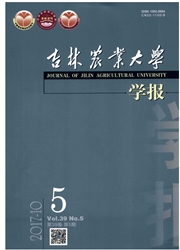

 中文摘要:
中文摘要:
根据CBF(c.repeat binding factor)AP2/EREBP保守区设计1对简并引物,采用PCR方法对月季‘寒锦4号’(Rosahybrida‘Hanjin4’)CBF转录因子基因中间片段进行克隆;再根据中间片段区域设计了两对特异引物,采用反向PCR方法对该基因的5r和3端的序列进行克隆,将中间片段与反向PCR产物拼接得到CBF基因全长序列,命名为RhCBF,GenBank注册编号为EF582843;该基因序列长758bp,ORF为603bp,编码200个氨基酸;同时,根据基因序列设计1对特异引物,利用荧光定量PCR分析月季CBF在不同逆境胁迫下的表达情况。结果显示低温和盐均可以诱导RhCBF的表达,而干旱处理不能诱导其表达。
 英文摘要:
英文摘要:
We firstly cloned the partial fragment of CBF from Rosa hybrida 'Hanjin 4' using homology cloning methods according to AP2/EREBP conserved sequences. Then, two pairs of specific primers for inverse PCR were designed to clone the 5' and 3' end sequences of CBF gene, respectively. The resulting 5' and 3' end sequences and the partial fragment were combined to a full length sequence, which was named RhCBF and submitted to GenBank (Accession number: EF582843 ). The full-length of cDNA is 758 bp and the open reading frame (ORF) is 603 bp, encoding 200 amino acids; According to Real-time PCR analysis using a pair of specific primers, we found that salt, low temperature stresses could induce the expression of RhcCBF dramatically, but the rnRNA level of RhCBF could hardly induced by drought treatment. These results show that RhCBF would play a critical role in salt and low temperature stresses.
 同期刊论文项目
同期刊论文项目
 同项目期刊论文
同项目期刊论文
 Sequence mining and transcript profiling to explore differentially expressed genes associated with l
Sequence mining and transcript profiling to explore differentially expressed genes associated with l Coexpression of ScNHX1 and ScVP in Transgenic Hybrids Improves Salt and Saline-Alkali Tolerance in A
Coexpression of ScNHX1 and ScVP in Transgenic Hybrids Improves Salt and Saline-Alkali Tolerance in A Cloning of a Vacuolar H+-pyrophosphatase Gene from the Halophyte Suaeda corniculata whose Heterologo
Cloning of a Vacuolar H+-pyrophosphatase Gene from the Halophyte Suaeda corniculata whose Heterologo Transcriptome Exploration in Leymus chinensis under Saline-Alkaline Treatment Using 454 Pyrosequenci
Transcriptome Exploration in Leymus chinensis under Saline-Alkaline Treatment Using 454 Pyrosequenci 期刊信息
期刊信息
